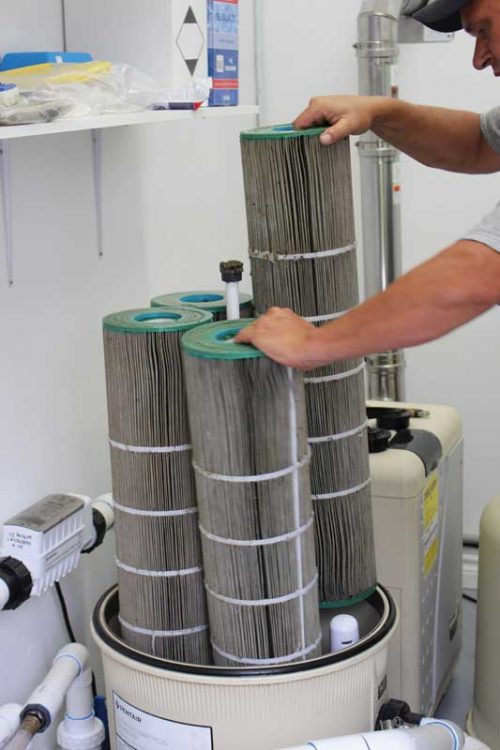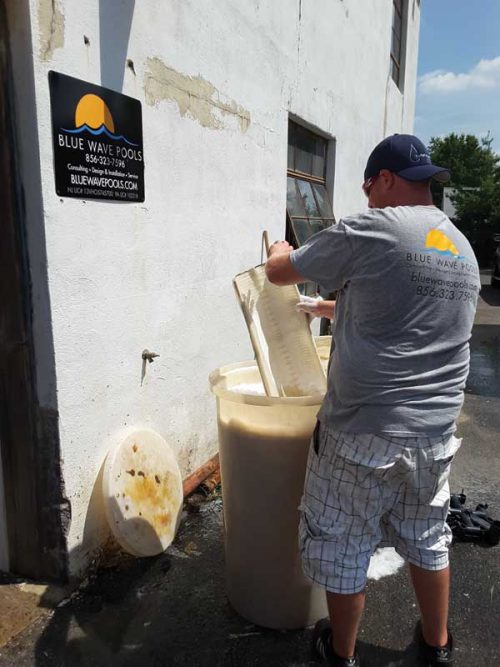Cleaning pool filters

The most common cleaning procedure for any type of pool filter is backwashing. That said, there are several best practices for each filter type. The following are some tips service technicians can use based on the type of filter they are working with.
Sand filters
Sand filters are still one of the top filtration methods used throughout the industry and, therefore, it is important service professionals are aware of the proper backwashing and sand cleansing procedures for this equipment.
Technicians should begin by determining the proper backwash flowrate 57 to 76 litres per minute (lpm) (15 to 20 gallons per minute [gpm]) per 0.1 m2 (1 sf). For example, a 0.28-m2 (3.1-sf) sand filter needs no less than 176 lpm (46.5 gpm) and no more than 235 lpm (62 gpm).
Too much water flow could potentially lift the sand bed and pass it to waste or worse, it can damage the laterals and/or filter tank from the sand blasting effect as the water is introduced at the bottom of the tank at a high velocity. However if there is not enough water flow, the debris will not be entirely removed from the sand bed. Anything that is left to remain will work its way deeper into the filter.
Should this occur, the debris at the bottom of the filter can turn to ‘caliche’ (a hardened natural cement of calcium carbonate that binds other materials—such as gravel, sand, clay, and silt) and the equipment will likely need to be replaced as it is extremely difficult to remove because of its size and the inability to break it up.
“When we open up the filter to winterize the pool, we discover the laterals are broken or we see sand in the pool, which often means the laterals are broken,” says Brett Huston, the owner of Patio Pleasures in Wisconsin. “We keep extra filter parts on our trucks, such as laterals, O-rings, gaskets, and multi-port valves, so we can quickly and efficiently fix our customers’ filters.”
That said, it is good practice for service companies, as part of their winterizing procedures, to fix any problematic filters before the pool is closed. It is also suggested service techs warn the customer that there can be a lot of time and cost associated with changing the media in a sand filter. For instance, in extreme cases, a technician could spend a better part of a day chiselling out sand from a filter. Therefore, it is important technicians know how to keep a sand filter functioning properly. One of the best ways a service tech can do this is by adding a dry clarifier when cleaning the media. When a technician is performing this procedure it is important they first turn off the inlets for all chemical feeders. Then, with the pump running, and the filter in the backwash position, 170 to 453.5 g (6 to 16 oz) of dry clarifier should be added through the skimmer. To do this, the skimmer basket, along with any material in the skimmer, has to be removed first. Then, based on the pool’s volume, a technician should add 4.9 mL (1 tsp) into the skimmer for every 18,927 L (5000 gal) of water. After adding the clarifier, the filter should be operated normally.
The clarifier can also be added directly into the filter media and left to soak for four or more hours. After soaking, the pump should be started with the filter in the backwash position.
The clarifier completely washes out the filter during the backwash and does not leave any residual. As sand does not necessarily filter out small particles (small micron size), adding a dry clarifier can help the customer’s filter work better as it increases filter efficiency by penetrating the sand with a highly effective polymer formula to restore water quality after heavy bather loads and/or rain. The product attracts all matter as small as two microns and captures it in the filter.
Another problem with backwashing sand filters can occur when it is done too frequently in dry and/or dusty regions. In some cases, silt can pass right through the filter when it is clean. When this happens, service techs often get calls from customers saying they have sand in their pool and additional sand comes out of the pool returns when they are vacuuming. To diagnose this situation properly, technicians should start by brushing the pool to see whether the sand makes a pile or a cloud in the pool. If the former happens, there could be an issue with the filter; however, if the latter occurs, it is silt not sand.
If it is ‘silt,’ the problem is the sand filter is too clean and, therefore, it should not be backwashed. When a sand filter is very clean, it allows larger particulate to pass through. This is a sign for technicians/homeowners to stop backwashing the filter and, instead, allow it to load up so it can trap the silt. A clarifier or flocking agent can be added to the filter to help with this process.

Technicians should not determine how long to backwash a sand filter by looking at the water flowing out of the line. They should not guess, either. That said, it is a good idea for service pros to use a stopwatch when performing this task as it should not take any longer than three minutes.
It is also important to remember that eventually the sand in the filter must be changed. The media has a lifespan, too, and at some point it can no longer just be cleaned. That said, the job of changing the sand can be challenging and time consuming.
“Depending on the size of the filter and how dirty the sand is, changing the media can take us anywhere between one and six hours to complete,” says Huston. “In terms of how frequently the sand needs to be changed, it’s a good idea to set expectations with the customer. For example, when dealing with our commercial pool clients, we tell the facility operator they must change the sand every three to five years depending on the bather loads of the pool.”
Pool professionals use a variety of tools when cleaning and changing sand from filters. Generally, a shop vac is used to speed up the process, as opposed to doing it by hand; however, some technicians may resort to using screwdrivers, chisels, or whatever can fit into the narrow area available once the filter has been opened.
“We prefer to change the sand in filters in the spring—after it has sat empty all winter and has dried out—so the sand doesn’t have all the water in it making it heavy,” says Huston. “The lighter the sand, the easier it is to remove it quickly.”






